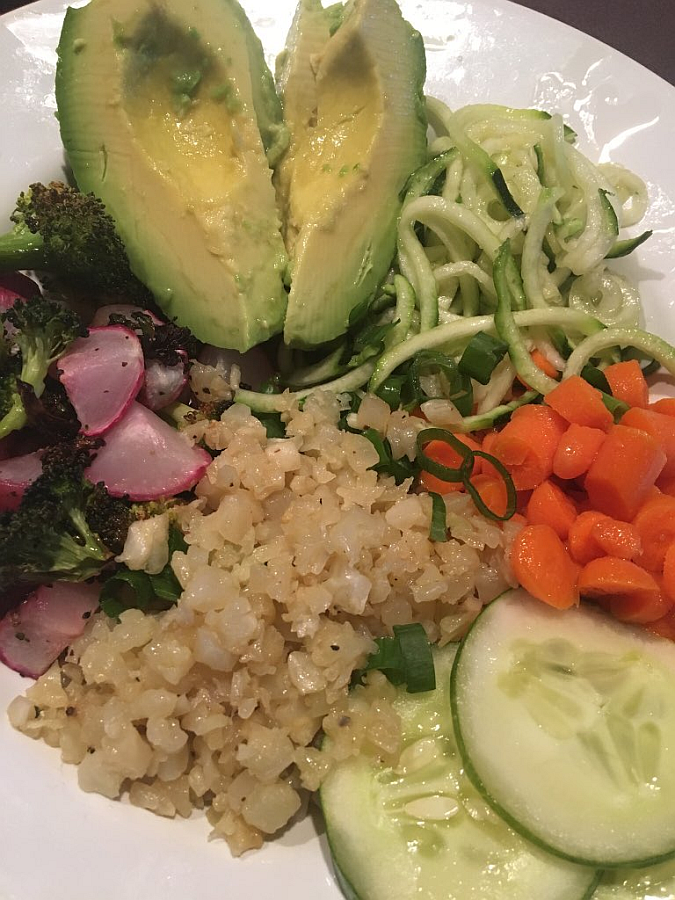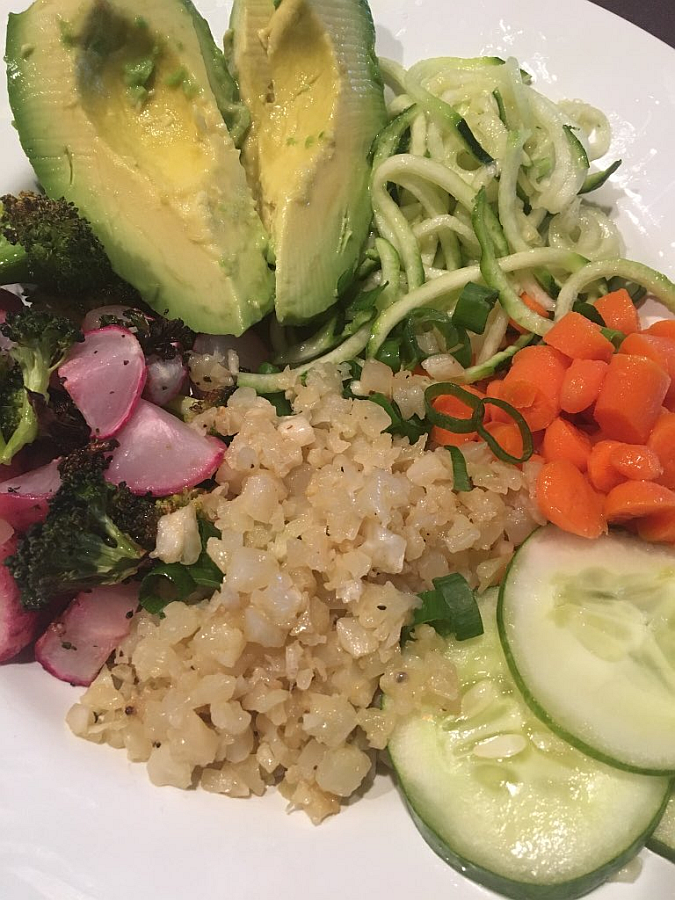When I had to give up gluten and wheat (health reasons), I became obsessed with “bowls” – simply putting food that I may have once put between bread into a bowl with various vegetables as costars. Sloppy Joes were no longer piled onto buns but were, rather, layered into bowls with onions, pickles, lettuce, tomatoes, and (when I’m feeling carb-tastic) fried potatoes.
Somewhere along the way “bowls” have become a really big deal nationwide – not just in my kitchen.
One of the biggest stars in the world of bowls right now is the simple, humble, and outrageously delicious Buddha Bowl.
I’ve heard “Buddha bowls” also referred to as glory or hippie bowls, but I like the name Buddha Bowl best. It just seems to fit.
Buddha Bowls are healthy, beautiful, VERY filling dishes that are made up of your choice of vegetables, beans, and a healthy grain (rice, quinoa…). The vegetables can be roasted, boiled, sauteed, or even raw. My personal preference is to have a combination of both cooked and raw. I’m not sure why, but it’s absolute perfection.
When I first made Buddha Bowls for my husband and I, I told him beforehand, “If you get hungry later, I’ll make you some bacon and eggs…” I honestly wasn’t sure how filling they’d be. Suffice to say, not an egg was cracked and the bacon was undisturbed. When we slowly got up from the table, we both agreed… they’re VERY filling!
While I didn’t do it in the meal pictured here, topping your Buddha Bowl with pumpkin seeds, sesame seeds, sunflower seeds, or chia seeds ups the looks as well as the nutrition and taste.
Some of my favorite ingredients for Buddha Bowls:
Avocados
Obviously this will fall under the “uncooked vegetables” category. Simply (but carefully) cut your avocado(s) into wedges, drizzle with lime juice, and lightly salt.
Zucchini “Noodles”
Zucchini noodles (made, of course, by spiralizing zucchinis) are nutritious and delicious, but if we’re being totally honest, when it comes to Buddha Bowls… well….I love them for their looks! I toss mine in raw, with just a splash of salt and a little lemon juice. You could, of course, cook them briefly but I like the texture of uncooked zucchini noodles.
If you don’t have a spiralizer, be sure to check produce sections. Many stores are now selling zucchini noodles.
Rice, Brown Rice, Quinoa, or Cauliflower Rice
The pictures shown have cauliflower rice but I’m just as crazy about the other grains named above. If you’ve never cooked with quinoa before, you honestly have to. It’s delicious and FUN. And who isn’t up for a little more FUN in the kitchen?!
If you aren’t keen on the idea of ricing your own cauliflower (even though it is easy peasy in a food processor – simply place chunks into the food processor and process until the cauliflower is the consistency of rice), check grocery stores. I’ve seen Cauliflower Rice sold in the produce sections of Meijer’s and Kroger. Cauliflower rice cooks easier than the others, which makes it an easier as well as healthier option.
Carrots
I like for my carrots to have a bit of bite to them, so I just boil them until they’re “fork tender.” As with most vegetables, I keep a fork right beside the stove. When the fork can pierce the vegetable without any resistance, I know we’re good to go. Overcooking vegetables leads to smooshieness, which is never good to the taste or eyes.
Roasted Radishes
- Preheat oven to 450 degrees. Line a baking sheet with parchment paper or foil.
- Cut radishes into halves.
- Toss radishes in olive oil (about 1 TBS per bunch).
- Spread radishes onto prepared baking sheet and sprinkle with salt. Be sure they aren’t touching one another.
- Roast (tossing every 5 minutes) for 15 to 20 minutes.
Roasted Broccoli
I use the same approach for broccoli as I do for radishes when roasting. In fact, I often roast them together.
Cucumbers
Raw… never cooked. I mean, why would you???
Squash
I had used up all of my crookneck squash for a meal the night before (fried, along with green tomatoes – it doesn’t get any more Southern or delicious), so there was no squash in the meal shown here. It is, ironically, one of my favorite Buddha Bowl guests, however. I love the color as much as the taste.
Spaghetti Squash is also fantastic in these bowls. My oldest daughter, Emily, and I could eat spaghetti squash 7 days a week. Whatever it is that it’s got, we’re wild about it!
Corn
Whether it’s boiled, roasted on the cob, then scraped off or roasted frozen corn (SO EASY!), like squash, corn adds great color and taste as well as texture to your Buddha Bowl.
Etc…
Chickpeas (raw, heated, or roasted), beets, shredded cabbage, black-eyed peas, black beans, wax beans, green peas (I like to use frozen peas for bowls and salads. I keep them in the freezer until right before I begin the meal. As we’ve established, however, I am uncommonly here for the crunch, so use your own preference as your guide.) The options are almost endless.
One tip, though, when using uncooked canned beans – drain them well and allow them to sit in the container before tossing them into the bowls. Same goes for cooked beans. Drain really, really well so they don’t bring their bath water with them!
As with most things, when it comes to cooking, it’s all about personalizing your meals to your family’s needs and likes. Make the bowls your own by adding your favorite vegetables and combinations. I read where a woman once ALWAYS (not usually… ALWAYS) paired frozen peas and beets in her Buddha Bowls. Me? I’d never go down that particular road… but it’s her vehicle, she’s free to drive it where she chooses!
When I first saw her pics, I thought, “Ummm…. not… sure… about… that…” but then I thought about it and I realized that she was to be commended. She was adding her own twist, creativity, and personality to her bowls and THAT is the whole idea.
One final tip: When it comes to planning your meals – whether they’re casseroles, salads, soups, side dishes, or bowls – do a little research into the health benefits of vegetables. Each one wields its own superpowers. If you combine several different “powers,” you’ll have yourself an especially powerful meal!

